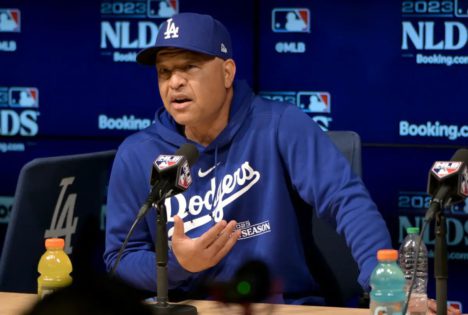Speed and explosiveness are the lifeblood of both track and field and the NFL. Whether it’s a sprinter blazing down the track or a wide receiver breaking away on a route, the need for elite speed is the same. For years, football players leaned heavily on track training to sharpen their quickness and acceleration and overall athleticism. But nowadays, things are shifting and not necessarily for the better. And seeing this veteran track coach is now openly frustrated with NFL coaching staffs for not fully leveraging the benefits of track training in today’s game.
In a recent episode of the Ready Set Go podcast, Olympic champion Justin Gatlin and veteran coach Rodney Green hosted University of Florida’s head coach Mike Holloway, a 17-time SEC champion and the coach of World Champion hurdler Grant Holloway. Their conversation centered around a growing shift: the weakening link between football and track and field.
Coach Holloway was blunt: “The days of the football track guy are probably done… These guys are making, like, a quarter million dollars—or more—to play football. You think teams are going to risk that investment by letting them run track? I don’t think so.” According to Holloway, the high-stakes nature of professional football now makes track participation a financial liability for many athletes and franchises.
Justin Gatlin challenged that idea, asking, “You don’t think track has been a crucial tool for their success on the field?” Holloway agreed but pointed out the gap in understanding: “Oh, I think it does, yeah. But I don’t think football coaches and strength coaches realize that. That’s the issue.” Green jumped in, highlighting how elite NFL athletes, like DK Metcalf, Christian McCaffrey, and Jaylen Waddle, often have track backgrounds.
“They all ran track. They’ll even say it in interviews: ‘You want speed? Go to the track.’ Because that’s the one thing you can’t just build in the offseason.” Even Tyreek Hill, known as one of the fastest players in NFL history, still includes track and field workouts in his routine. Coach Holloway also shared a telling story from a consultant who recently worked with the Carolina Panthers.
After most players finished their drills, Christian McCaffrey stayed behind to do a track-style sprint session. The consultant asked, “Why aren’t y’all doing what he’s doing? He’s the fastest guy on your team.” That moment, Holloway said, “spoke to the mentality gap. Again, I’m not bash strength coaches, but they could be better if they tapped into the knowledge track coaches have.”
The podcast wrapped with Holloway asking a critical question: “As you look across the NCAA track scene, how many football players are running track right now?” Justin answered plainly, “Not many.” The conversation served as both a reality check and a call to action. Track and field still has the power to unlock greatness on the football field, but only if the system allows it. Need proof? Just look at the NCAA champions.
Track and field and football boost NCAA athletes’ careers
NCAA athletes who compete in both track and field and football are increasingly showing that pursuing multiple sports can significantly boost their athletic development and career opportunities. Take Quincy Wilson, a 17-year-old sprinter from Bullis School, Maryland, who not only set world-best times in the 400m but also excelled as a high school football defensive back and wide receiver.
Credits: Instagram
Similarly, Jordan Anthony, an explosive sprinter who ran a remarkable 9.95 seconds in the 100m, balances his track career while playing wide receiver for the University of Arkansas. These athletes show how track training sharpens speed, agility, and explosiveness, which directly translates to better football performance. Engaging in multiple sports allows athletes to develop a wider skill set.
This makes them more attractive to college recruiters and professional teams. For example, Randall Cunningham II, a former USC high jumper and high school quarterback, leveraged his dual-sport experience to succeed in both arenas. Additionally, competing in more than one sport helps reduce the risk of overuse injuries by working different muscle groups and movement patterns while fostering mental toughness and adaptability.
As NCAA programs increasingly support multi-sport athletes, the benefits become obvious: better physical conditioning, greater career flexibility, and enhanced resilience. This approach provides athletes with a more sustainable path to peak performance and broader opportunities, both on and off the field. For many, excelling in both track and field and football is not just possible, it’s a winning formula.
The post Veteran Track and Field Coach Airs Frustrations with NFL Coaches After Major Change appeared first on EssentiallySports.



